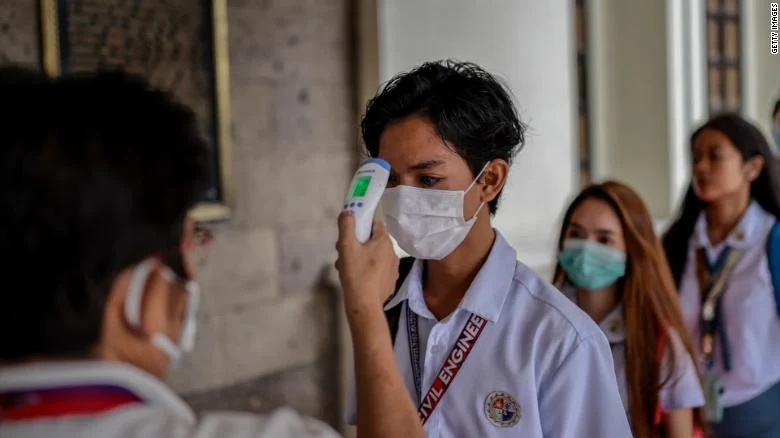Coronavirus Pandemic COVID-19: 9 Symptoms To Watch For
Researchers are beginning to understand the symptoms of COVID-19, the new coronavirus. Here's what you need to know.
A global concern
The new coronavirus has now infected thousands of people around the world and a more accurate picture of the constellation of symptoms caused by the virus is beginning to emerge.The infection has been named COVID-19 and the World Health Organization (WHO) has declared it a pandemic.
According to the Centers for Disease Control and Prevention (CDC) in the United States, in people with the coronavirus, or COVID-19, the illness can be mild, severe or even fatal.
Most cases - about 80 percent - are mild, says Dr. Robert Glatter, an emergency physician at Lenox Hill Hospital in New York City.
But the symptoms are also "non-specific," adds Dr. Nestor Sosa, head of infectious diseases at the University of New Mexico's Albuquerque School of Medicine.
This means they can be confused with symptoms caused by other respiratory diseases such as colds and flu.
People are rushing to put on face masks because of VIDOC-19. But where does this fear of running out of face masks come from?
The three most common symptoms of VIDOC-19 seem to be fever, cough and difficulty breathing. We will describe them in detail along with the other symptoms that are less common.
Fever
The most marked symptom of coronavirus appears to be a fever.
A CDC report indicates that 77% to 98% of hospitalized people with the virus have a high temperature.
Another analysis indicates that the fever is typically at least 38°C (100.4°F), and is sometimes accompanied by chills.
Note that fever may not be the first symptom. About 44% of more than 1,000 patients hospitalized in China for coronavirus had a fever when they arrived at the hospital, according to a study in the New England Journal of Medicine. This figure rose to 89% after their hospitalization.
Cough
TOMMASO79/SHUTTERSTOCKThe second common symptom is cough, which affects 46% to 82% of hospitalized patients, according to the CDC.
Coughing is a common symptom, but in the case of COVID-19, it is usually a dry cough, Dr. Sosa adds.
The CDC believes the disease is spread primarily by droplets from the respiratory tract in people who are within 1.80 meters (6 feet) of each other.
That's why people with symptoms should cough or sneeze into a tissue or the crook of the elbow, not their hands, the Public Health Agency of Canada recommends.
Difficulty breathing
It is a worrisome symptom that affects between 3% and 31% of hospitalized patients, according to the CDC.
A study published in the International Journal of Antimicrobial Agents (IJAA) brings this number to 34.5%, making it the third most important symptom.
Difficulty breathing can be a major source of anxiety and can get worse.
The AJAI article states that patients with IDVOC-19 who are in the emergency department are more likely to experience shortness of breath than those in other departments.
Respiratory symptoms are one of the characteristics of IDVOC-19: many patients end up with pneumonia and some need to be placed on oxygen therapy or mechanical ventilation.
Exhaustion is also a common symptom of infection, according to the WHO, which estimates it at 38.1%.
Muscle aches and pains
Some 13.9% of patients monitored by WHO reported muscle pain.
According to the Cleveland clinic, this is a common symptom in viral infections, such as colds and flu, although, according to Dr. Glatter, this symptom is more sudden in the flu.
In mild coronavirus infections (the majority of cases), the symptoms should go away on their own, but call the doctor's office if they are more severe than a cold.
Headache
Patients with IDVOC-19 complained of headaches in the same proportion, according to WHO, as those with sore throats.
Both symptoms were quite rare. There are, of course, many different types of headaches, which can have many possible causes, including stress.
That said, if you have headaches with symptoms such as fever, cough, and difficulty breathing and you have traveled recently, or live in an environment where there is a contagion, call your doctor.
Diarrhea
Few subjects with IDVOC-19 reported diarrhea (3.7% according to WHO), but it is a non-respiratory symptom to be monitored all the same.
In fact, according to the American Foundation for Infectious Diseases, coronaviruses can cause diarrhea in cows and pigs (infected chickens tend to have respiratory illnesses).
The first confirmed case of coronavirus in the United States - a 35-year-old man returning to Washington State from a stay in Wuhan, China - had diarrhea soon after his hospitalization.
His stool samples were positive for VIDOC-19, according to an article in the New England Journal of Medicine.
Patients with SARS and those who had Middle East Respiratory Syndrome (MERS CoV) reported gastrointestinal symptoms, according to one study.
Nasal discharge
...or even a lack of a runny nose. Only 4% of patients in one sample reported nasal discharge, but the absence of nasal discharge is also noteworthy.
"COVID-19 tends to have lower respiratory tract symptoms rather than upper respiratory tract symptoms, such as the nose," explains Dr. Sosa.
The Stanford University Children's Health Center recommends that children with nasal congestion accompanied by fever, cough, and nausea be tested for influenza.
Those who have fever, cough, breathing difficulties and fatigue without runny nose or nausea are candidates for the VIDOC-19 test. Most cases of COVID-19 in China were adults, not children, CDC reports.
Absence of symptoms
A report from the WHO reports asymptomatic cases of IDVOC-19 (patients had no symptoms), but it should be noted that the majority of patients subsequently had symptoms.
This leaves an important concern: can people who have the coronavirus but no symptoms transmit the disease? The CDC believes asymptomatic transmission is possible, although the WHO says that the main transmission of the infection is not this way.
Coronavirus Pandemic: The World Comes To a Standstill, Psychosis Progresses
Treatment
There is no specific treatment for VIDOC-19, although researchers are analyzing and testing existing drugs.
According to an article published in Nature, they have so far tested HIV drugs (ritonavir and ASC09) and the antiviral remdesivir, developed to treat Ebola.
Apart from these, patients receive "supportive care": fluids, analgesics, antipyretics (to bring down fever) and, if necessary, oxygen and mechanical ventilation.
For those who are homebound with mild symptoms, AAFP recommends rest and plenty of fluids. However, it's best to call the coronavirus hotline or doctor's office if you are having difficulty breathing.
Name
Health




